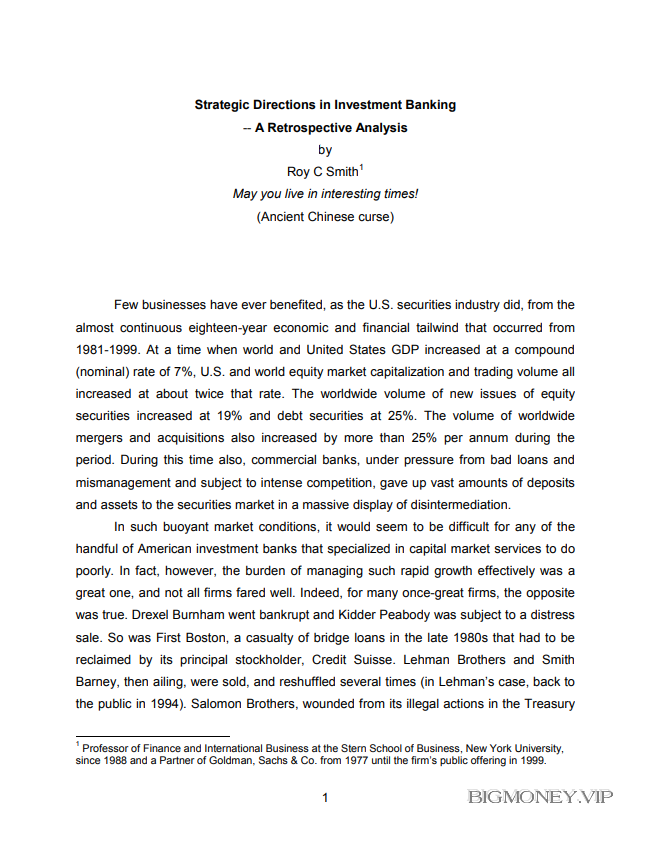Strategic Directions in Investment Banking -- A Retrospective Analysis by Roy C Smith

bond auction market in 1990, never fully recovered and was sold to a division of The
Travelers Group. A number of other US firms that were generally thought unable to
keep up with competition, including Dillon Read, Chase Manhattan, JP Morgan and
Paine Webber, found merger with a stronger partner (although at a decent price) their
best strategic alternative. Table 1 is a partial list of notable investment banks that
disappeared during these past two decades.
Change and Competition
With all the financial market expansion resulting from disintermediation,
deregulation, globalization and new technology there was also an avalanche of
competition. For those who could make the most of the new environment and compete
effectively, opportunities for growth and enrichment appeared limitless. For all others in
the financial services industry, however, the times presented as much turmoil,
confusion and distress as during any similar period they had ever experienced. During
this time it was almost impossible to direct and manage investment banking businesses
as they had been managed during the preceding twenty years. So much was changing
so fast, every firm in the industry had to reconsider its essential strategy for growth and
survival.
The process for doing this under pressure was often inchoate and quickly
cobbled together. But the firms knew that while they were in danger of being
marginalized by competitors, there were also, for those who succeeded, opportunities
for great rewards. By “success” most firms would say they meant preserving their
essential culture, customer franchise and ways of doing business, but this would be
impossible. Much of these traditional ways of doing business had to change in order for
firms to be able to compete effectively. And competitive results were measured chiefly
along two important axes: market share and profitability. They either had to reorganize
themselves so as to be able to perform well under these difficult measures, or save
what they could of their investment by selling the firm or taking their chances in a sub-
specialized niche.
The 1980s were watershed years for investment banks. This was the decade of
the S&L crisis (which created a sudden need for securitization of mortgage securities),
burgeoning US government deficits (which greatly expanded Treasury securities
markets), and the largest mergers and acquisitions boom in the century. It was a
decade in which financial markets were also being affected by widespread deregulation,
new technologies, and rapid international expansion.
These developments pushed investment banks into a major transformation. The
leading players became “integrated “ investment banks that brought all of their
capabilities together into a core that could service clients on an immediate basis. The
concept of “block trading” with institutional customers was transferred to the
underwriting business with the introduction of the “bought deal,” and the “bridge loan” to
facilitate client transactions. “Capital market groups” would scour the world for
innovative or low cost financing opportunities to be presented immediately to a dozen or
more existing clients or prospects. Execution could occur immediately, on the phone.
Merger teams too would combine the skills of top securities analysts and arbitrageurs
with deal experts to offer clients all they could ever want in the way of transactional
expertise. Relationship managers scurried to be sure that no service a client might need
was overlooked, and a team of experts offered. These managers, teams and groups so
no need to confine their efforts to serving existing clients, they went after the clients of
other firms as well, and the clients were ready to pick the best deal and the best price,
rather than rely on traditional relationships.
By the end of the eighties, firms like Merrill Lynch, Goldman Sachs, Salomon and
Drexel had increased their market shares (especially in the US) at the expense of the
more conservative, less adaptive old guard.
They had been very focused on perfecting
the quality of their services and the aggressive marketing that promoted them. All
survived the stock market crash of 1987, but criminal misconduct in the junk bond
business finished Drexel in 1990. It also collapsed the junk-bond market that Drexel
dominated, thereby ending the takeover boom (which was in its last, overpriced stages
then anyway) and the ability to refinance large bridge loan positions taken on by First
Strategic Directions in Investment Banking -- A Retrospective Analysis by Roy C Smith




